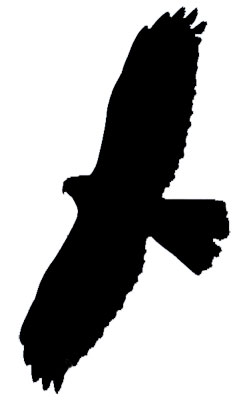
Home | About Us | Projects | Maps | Facts

Home | About Us | Projects | Maps | Facts
|
Red-tailed Hawk (Buteo jamaicensis) Description: The Red-tailed Hawk is a medium-sized bird of prey know as a raptor. They have long, broad wings and short, wide tails with reddish brown color. Juveniles lack the red tail. These hawks are often seen perched near roadsides or soaring over open fields. The Red-tailed Hawk displays sexual dimorphism in size, as females are about 25% heavier than males. 
Call: Call a raspy, scraping, screamed "kree-eee-ar." The raspy cry of the Red-tailed Hawk is used in movies to represent any eagle or hawk anywhere in the world. Listen to calls of this species » Range / Habitat: The Red-tailed Hawk is one of the most widely distributed hawks in the Americas. It breeds from central Alaska, the Yukon, and the Northwest Territories east to southern Quebec and the Maritime Provinces of Canada, and south to Florida, the West Indies, and Central America. The Red-tailed Hawk occupies a wide range of habitats and altitudes, including deserts, grasslands, forests, agricultural fields and urban areas. This species is common in most habitats throughout the state. Generally they are only absent from dense coastal rain forests, sub-alpine and alpine forests and parkland, dense inner cities, and permanent ice and snow. Click the range map to learn more about the distribution of Red-tailed Hawks in California. 
Diet: Red-tailed Hawks eat small mammals, especially rodents and rabbits. They also eat birds, reptiles, fish and insects. Nesting: Red-tailed Hawks build nests in a tall trees, often the tallest tree in a cluster or on cliff ledges. Towers, nest platforms, and buildings are also used for nesting. In western Washington, the nest is usually in a hardwood tree, especially black cottonwood or red alder. Both male and female help build the nest, a collection of sticks lined with bark and other material. Both adults help incubate the 2 to 3 eggs for 28 to 32 days. The female stays on the nest and broods the young for the first 30 to 35 days after they hatch. The male brings food to the female who to feed the young. After 42 to 46 days, the young leave the nest, but they can't fly for another 2 to 3 weeks. Behavior: Red-tailed Hawks are well adapted for soaring and spend long periods riding thermals, searching for prey. It is frequently seen sitting on utility poles or snags where it watches for rodents in the grass along the roadside. Did you know?
More information: Animal silhouettes available to purchase » Photos: Natures Pics |